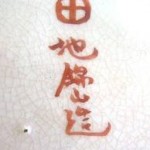I get messages asking if pieces of inherited or bought pottery are genuine and if I can give an approximate value. Apart from people looking for information on Satsuma Pottery or getting a great deal on the eBay listings I provide on each page, this is the most common reason people might visit this site.
Get your pieces valued here, using our recommended online service.
So how do you tell if a piece you own is a genuine antique Satsuma vase, plate or button?
Actually, it is much simpler than you think and with the item in your hands, the only question you need to ask yourself is "where is the marking and what does it look like?".
The "makers mark" or marking on each Satsuma piece is the key to unlock the value, age and authenticity. Looking at the marking will let you know a rough date and if the item is worth anything or not.
Check for English words first.
So you have the piece in your hand now and have flipped it over and found the marking - what next?
First of all, look to see if there is any english words on the marking, such as "Made In Japan" or "Hand Painted". If there are, then the piece is most certainly NOT an antique.
Once the Satsuma style was seen by the general public and became a popular look, the style was mass produced across the world (usually in China) and stamped with these sorts of markings. If your piece has this on, it is probably made in the later half of the 20th century and will not be worth a great deal of money.
However, collectors do still want these items and if they are good condition or come with a good story, then you might get some money for it on eBay.
Check for the Shimazu crest.

Another good sign of an authentic antique mark is the presence of the Shimazu family crest. A simple circle with a cross through it is the sign of the clan that ruled the Satsuma province in Japan around the time that most of the original items were made. If this crest is on the pottery item, then you most likely have an original piece.
The crest should also be accompanied by a signature or mark of the maker and is often painted in gold strokes. The Kanji (Japanese symbols) will often be the name of the maker or sometimes a number, placing the piece as one of a series of potteries, designed to be displayed in a certain order.
Is the makers marking hand painted or stamped on?
All of the original Satsuma pottery pieces were made, glazed and painted by hand. Therefore, you should be able to see if the marking has been painted by hand or stamped on.
If a stamp or print has been used to mark the piece, you may have a more modern item - most likely mid to late 20th century and worth less value. Obviously, a stamped mark will look more “perfect” than a hand painted one, so it should stick out like a sore thumb.
Do you know the history of the piece?
Many of you contact me with stories of inherited pieces of Satsuma pottery or asking for information about a family heirloom that has been passed down through the years. Knowing where and when the Satsuma pieces came from can also help determine their value.
Due to the style becoming so popular in more recent years, many people purchased (not inexpensive) pieces that have stayed in the family for many years, only to be found again or looked at in more detail more recently. If you are able to find out when the pieces were purchased, it may help you work out how old they are.
The more modern items are mass produced and are marked with English writing, which should be a good indicator of their age.
Does it "ring"?
One of the obvious differences between porcelain and earthenware pottery is that the former is very thin, which allows you to hold the item and tap it, producing a "ring" sound. You can probably test this on some more modern items you have at home.
The fact that Satsumaware is made from clay and earth means that they have generally thicker "walls" and the material will not allow a "ring" when tapped. You can test your Satsuma piece yourself to see if it will produce a high pitched round when tapped. If you get a dull sound, then you are more likely to have a genuine piece.
What to do next.
If you are really stumped and can’t find the information you need, there are a few other options you have.
Get a cheap online valuation.
We have partnered with ValueMyStuff where you can get your Satsuma pieces or other antiques. Read more about the service on our Satsuma Valuation Service page.
Check other useful sites.
The excellent Gotheborg satsuma markings site is a brilliant resource and is a great place to look for pictures of markings on Satsuma pieces. It should be easy to compare your marking with the ones there.
If you are feeling brave, use the Kanji by radicals site to construct the Japanese symbols and try to work out the meaning yourself.
Update Jan 2021: I have also come across the excellent Satsuma Database website, where they have a regularly updated PDF file with photos of markings.
Get some good Satsuma pottery books.
There are a number of good books at Amazon which are perfect for learning about Satsuma Pottery and identifying the piece you have. You can also check out our post of the best books to use to help you.